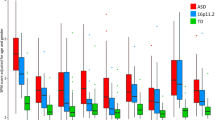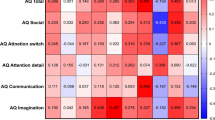Abstract
Sensory issues are widely reported in Autism Spectrum Conditions (ASC). Since taste perception is one of the least studied senses in ASC we explored taste identification in adults with ASC (12 males, 11 females) compared to control participants (14 males, 12 females). ‘Taste strips’ were used to measure taste identification overall, as well as bitter, sour, sweet and salty tastes. Results revealed lower taste scores overall in the ASC group, as well as for bitter, sour and sweet tastes. Salty taste scores did not differ between the groups. Examining error types showed that adults with ASC more often misidentified a taste as salty or as no taste. Future studies should investigate underlying mechanisms of taste identification difficulties in ASC.

Similar content being viewed by others
Notes
The MANCOVA was repeated excluding participants who were on medication. Adults with ASC showed lower taste scores (Pillai’s trace F (5,32) = 0.24, p = 0.05). Separate univariate ANOVAs showed lower taste scores overall in the ASC group (F (1) = 11.54, p < 0.002), as well as for bitter taste (F (1) = 4.62, p = 0.007), sour tastes (F (1) = 3.41, p = 0.02) and sweet tastes (F (1) = 3.51, p = 0.05). However, salty taste accuracy did not differ between the groups (F (1) = 1.85, p = 0.08).
References
A.P.A. (1994). DSM-IV diagnostic and statistical manual of mental disorders (4th ed.). Washington, DC: American Psychiatric Association.
Auyeung, B., Baron-Cohen, S., Wheelwright, S., & Allison, C. (2008). The autism spectrum quotient: Children’s version (AQ-child). Journal of Autism and Developmental Disorders, 38(7), 1230–1240.
Bandini, L. G., Anderson, S. E., Curtin, C., Cermak, S., Evans, E. W., Scampini, R., et al. (2010). Food selectivity in children with autism spectrum disorders and typically developing children. The Journal of Pediatrics, 157(2), 259–264.
Barker, R. A., Barasi, S., & Neal, M. J. (2003). Neuroscience at a glance (2nd ed.). Oxford: Blackwell.
Baron-Cohen, S., Hoekstra, R. A., Knickmeyer, R., & Wheelwright, S. (2006). The autism-spectrum quotient (AQ)-adolescent version. Journal of Autism and Developmental Disorders, 36, 343–350.
Baron-Cohen, S., Wheelwright, S., Skinner, R., Martin, J., & Clubley, E. (2001). The autism spectrum quotient (AQ): Evidence from Asperger syndrome/high functioning autism, males and females, scientists and mathematicians. Journal of Autism and Developmental Disorders, 31, 5–17.
Bennetto, L., Kuschner, E. S., & Hyman, S. L. (2007). Olfaction and taste processing in autism. Biological Psychiatry, 62(9), 1015–1021.
Bonnel, A., Mottron, L., Peretz, I., Trudel, M., Gallun, E., & Bonnel, A.-M. (2003). Enhanced pitch sensitivity in individuals with autism: A signal detection analysis. Journal of Cognitive Neuroscience, 15, 226–235.
Bradbury, J. (2004). Taste perception: Cracking the code. PLoS Biology, 2(3), E64.
Carpenter, R. H. S. (2003). Neurophysiology (4th ed.). London: Arnold.
Chamak, B., Bonniau, B., Jaunay, E., & Cohen, D. (2008). What can we learn about autism from autistic persons? Psychotherapy and Psychosomatics, 77(5), 271–279.
Cheung, P. P., & Siu, A. M. (2009). A comparison of patterns of sensory processing in children with and without developmental disabilities. Research in Developmental Disabilities, 30(6), 1468–1480.
Crane, L., Goddard, L., & Pring, L. (2009). Sensory processing in adults with autism spectrum disorders. Autism, 13(3), 215–228.
Dunn, W., Myles, B. S., & Orr, S. (2002). Sensory processing issues associated with Asperger syndrome: A preliminary investigation. American Journal of Occupational Therapy, 56(1), 97–102.
Grandin, T. (1996). Thinking in pictures. Vancouver, WA: Vintage Books.
Kern, G., & Carmody, A. M. (2007). Examining sensory modulation in individuals with autism as compared to community controls. Research in Autism Spectrum Disorders, 2(1), 85–94.
Kientz, M. A., & Dunn, W. (1997). A comparison of the performance of children with and without autism on the sensory profile. American Journal of Occupational Therapy, 51(7), 530–537.
Kinomura, S., Kawashima, R., Yamada, K., Ono, S., Itoh, M., Yoshioka, S., et al. (1994). Functional anatomy of taste perception in the human brain studied with positron emission tomography. Brain Research, 659(1–2), 263–266.
Landis, B. N., Welge-Luessen, A., Bramerson, A., Bende, M., Mueller, C. A., Nordin, S., et al. (2009). “Taste Strips”—A rapid, lateralized, gustatory bedside identification test based on impregnated filter papers. Journal of Neurology, 256(2), 242–248.
Lane, A. E., Dennis, S. J., & Geraghty, M. E. (2011). Brief report: Further evidence of sensory subtypes in autism. Journal of Autism and Developmental Disorders, 41(6), 826–831.
Naka, A., Riedl, M., Luger, A., Hummel, T., & Mueller, C. A. (2010). Clinical significance of smell and taste disorders in patients with diabetes mellitus. European Archives of Oto-Rhino-Laryngology, 267(4), 547–550.
Schreck, K. A., & Williams, K. (2006). Food preferences and factors influencing food selectivity for children with autism spectrum disorders. Research in Developmental Disabilities, 27(4), 353–363.
Schreck, K. A., Williams, K., & Smith, A. F. (2004). A comparison of eating behaviors between children with and without autism. Journal of Autism and Developmental Disorders, 34(4), 433–438.
Schumm, L. P., McClintock, M., Williams, S., Leitsch, S., Lundstrom, J., Hummel, T., et al. (2009). Assessment of sensory function in the National Social Life, Health, and Aging Project. The Journals of Gerontology. Series B, Psychological Sciences and Social Sciences, 64(Suppl 1), i76–i85.
Simmons, D. R., Robertson, A. E., McKay, L. S., Toal, E., McAleer, P., & Pollick, F. E. (2009). Vision in autism spectrum disorders. Vision Research, 49(22), 2705–2739.
Steinbach, S., Hundt, W., Vaitl, A., Heinrich, P., Förster, S., Bürger, K., et al. (2010). Taste in mild cognitive impairment and Alzheimer’s disease. Journal of Neurology, 257(2), 238–246.
Tsatsanis, K. D., Rourke, B. P., Klin, A., Volkmar, F. R., Cicchetti, D., & Schultz, R. T. (2003). Reduced thalamic volume in high-functioning individuals with autism. Biological Psychiatry, 53(2), 121–129.
Wakabayashi, A., Baron-Cohen, S., & Wheelwright, S. (2004). The autism spectrum quotient (AQ) Japanese version: Evidence from high-functioning clinical group and normal adults. Shinrigaku Kenkyu: The Japanese Journal of Psychology, 75, 78–84.
Wang, M., Marks, L. E., & Frank, M. E. (2009). Taste coding after selective inhibition by chlorhexidine. Chemical Senses, 34, 653–666.
Watling, R. L., Deitz, J., & White, O. (2001). Comparison of sensory profile scores of young children with and without autism spectrum disorders. American Journal of Occupational Therapy, 55(4), 416–423.
Wechsler, D. (1939). The measurement of adult intelligence. Baltimore: Williams and Wilkins.
Weiland, R., Macht, M., Ellgring, H., Gross-Lesch, S., Lesch, K. P., & Pauli, P. (2011). Olfactory and gustatory sensitivity in adults with attention-deficit/hyperactivity disorder. Attention Deficit and Hyperactivity Disorders, 3(1), 53–60.
Welge-Lussen, A., Dorig, P., Wolfensberger, M., Krone, F., & Hummel, T. (2011). A study about the frequency of taste disorders. Journal of Neurology, 258(3), 386–392.
Wiggins, L. D., Robins, D. L., Bakeman, R., & Adamson, L. B. (2009). Brief report: Sensory abnormalities as distinguishing symptoms of autism spectrum disorders in young children. Journal of Autism and Developmental Disorders, 39(7), 1087–1091.
Acknowledgments
TT was supported by the Pinsent Darwin Trust and Autistica during the period of this work. SBC was supported by the MRC UK. We are grateful to the participants for their generous cooperation and to Bonnie Auyeung, Jillian Sullivan and Bhismadev Chakrabarti for valuable discussions. This work was conducted in association with the NIHR CLAHRC for Cambridgeshire and Peterborough NHS Foundation Trust.
Conflict of interest
The authors of this paper report no biomedical financial interests or potential conflicts of interest.
Author information
Authors and Affiliations
Corresponding author
Additional information
This work was conducted in association with the NIHR CLAHRC for Cambridgeshire and Peterborough NHS Foundation Trust.
Rights and permissions
About this article
Cite this article
Tavassoli, T., Baron-Cohen, S. Taste Identification in Adults with Autism Spectrum Conditions. J Autism Dev Disord 42, 1419–1424 (2012). https://doi.org/10.1007/s10803-011-1377-8
Published:
Issue Date:
DOI: https://doi.org/10.1007/s10803-011-1377-8




